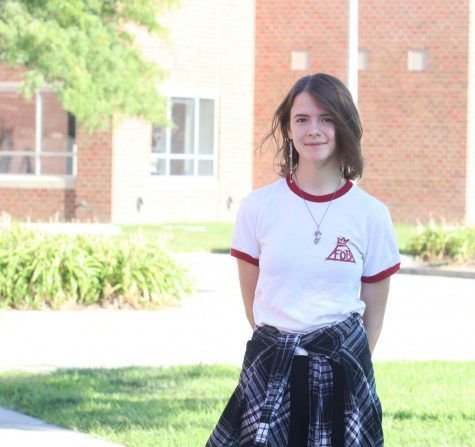Exploring faiths
World Religion students take a trip to different religious centers
Photo courtesy of Deepasri Bylore
One of the stops on the trip was the Beth El Synagogue. Here, they learned about the architecture within and what it means to the Jews who worship there. “The colorful curtains are meant to represent the seven days it took G-d to create the world, and, while it isn’t very apparent in the picture, the front half of the seats are in the shape of semi-circles,” senior Deepasri Bylore said. “The seats are a recent change from the original design inspired from the linear seat layout of churches and gives what the rabbi describes as a more personal atmosphere between a congregation and speaker.”
May 11, 2022
On Thursday, April 28, social studies teacher Matt Heys’ World Religions class took their annual field trip to different religious centers around the Omaha area. The experience allows students to expand their knowledge in their class and apply it to their studies.
The tradition started back when Millard West first opened in 1995 and decided to take trips to different religious centers around Omaha. It became a tradition when Mark Smith, a past World Religions teacher at West, told Heys “I can put my entire world religions class in a van and hit all these places in one day, but I feel bad making our hosts and guides interrupt their days for just a dozen visitors.” Thus, each World Religions class take part in the trip every semester since.
In past years, the class would attend five places of worship including the Hindu Temple, Beth El Synagogue, the Islamic Center of Omaha (or the American Muslim Institute, also known as the AMI), St. Cecelia’s Cathedral and St. John the Baptist Church (Greek Orthodox). However, with COVID-19, many places are still hesitant to open up their worship spaces, especially with the Omicron variant. Only Beth El Synagogue and the AMI accepted the students into their places of worship to take tours and experience the practices that happen within.
“I want my students to see firsthand what all of these places have in common, as well as what defines their unique character, not just in terms of how a given space reflects a religion’s values, but also how it relates to religious identity in a very pluralistic society,” Heys said. “Omaha, I’m sure to outsiders, has a reputation for being a kind of diversity desert, but it’s not —not in any dimension really, but certainly not in the religious one.”
Their first stop was to Beth El Synagogue, a conservative Jewish center of worship. Here, students were led by Rabbi Steven Abraham who is the first Rabbi of the synagogue in its current location (the community itself dates all the way back to the late 1920s). Beth El provides the best look into the Jewish faith as conservatism leans towards ideals seen in the Reform and Orthodox branches of Judaism.
When entering the synagogue, male students were encouraged to wear yarmulkes (skullcaps worn by Jewish men during prayer, or in the case of Orthodox Jews, in public). Rabbi Abraham then explained to the students the importance of the architecture within the synagogue, the different denominations found in the Jewish religion and even showed them the Torah scroll (the sacred text of the Jewish religion).
According to one student who went on the trip, going to the synagogue was able to help her in her studies pertaining to Judaism.
“I think this trip is very important for World Religions because it’s one thing to read about a religion in a textbook, but it’s another to hear firsthand the experiences of those who practice that religion,” senior Deespari Bylore said. “You get a better understanding of how they view themselves, how they structure their communities, and most importantly you can see their passion for their beliefs which makes you more appreciative of how these religions influence and help others find their place in the world.”
Their next stop was the American Muslim Institution (AMI). Brother Nizzam Qassem led the students through the mosque. Similar to how the men had to wear Yarmulkes when entering the synagogue, the women were asked to wear headscarves brought from home. Students had the opportunity to witness a full Asr, afternoon prayers, taking place at the time. They sat on a carpeted floor and witnessed the Imam (a person who leads prayer in a Mosque) lead those attending in a series of chants and poses for three minutes.
The AMI was in the middle of Ramadan, a sacred holiday in Islam, and they still accommodated the students showing how much it means that they took an interest in investing to learn about their religion.
“It brings them acceptance. It will help them learn how to deal with Muslims and treat them in the world and clear up a lot of misconceptions,” brother Qassem said. “They get to actually experience what a mosque is actually like and interact with people a part of the community. It’s more inclusive this way and it brings light to an already misunderstood religion. When the students come and see how the environment is very welcoming and answering their questions, I feel that they are getting the information they need from the source.”
By attending the trip, students not only expand their knowledge about each religion but become more accepting and understanding when it comes to those differences. This is one of the main goals Heys sets up for his class each semester and will continue to do so for generations of World Religions students to come.







